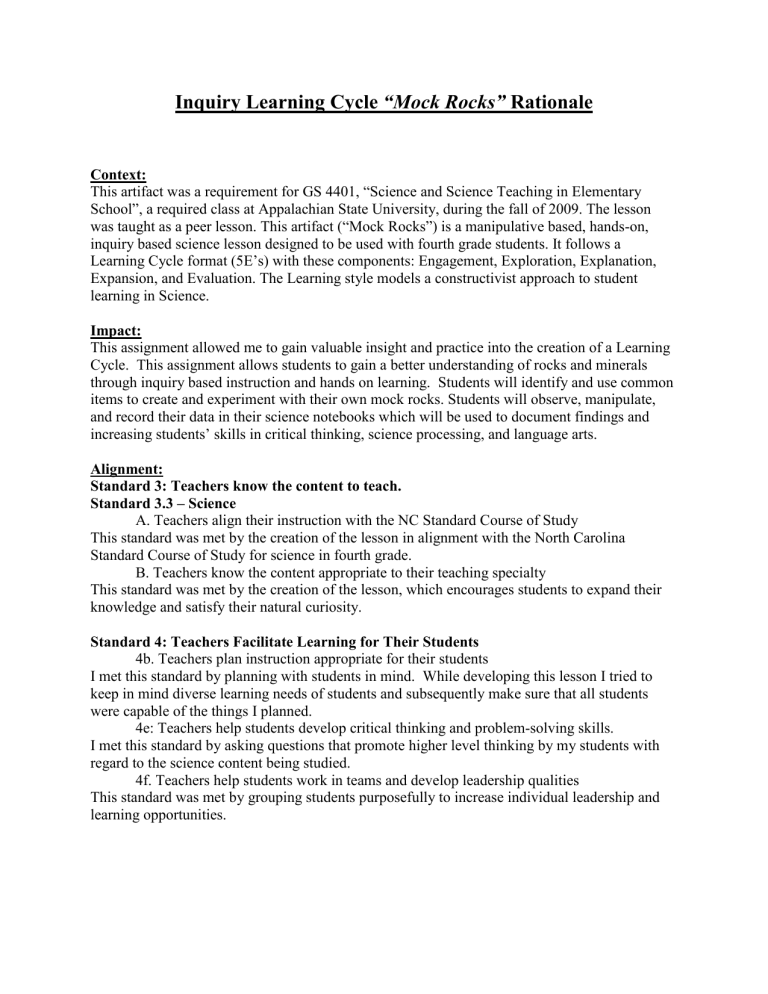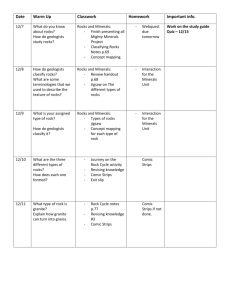Inquiry Learning Cycle – GS4401

Inquiry Learning Cycle “Mock Rocks” Rationale
Context:
This artifact was a requirement for GS 4401, “Science and Science Teaching in Elementary
School”, a required class at Appalachian State University, during the fall of 2009. The lesson was taught as a peer lesson. This artifact (“Mock Rocks”) is a manipulative based, hands-on, inquiry based science lesson designed to be used with fourth grade students. It follows a
Learning Cycle format (5E’s) with these components: Engagement, Exploration, Explanation,
Expansion, and Evaluation. The Learning style models a constructivist approach to student learning in Science.
Impact:
This assignment allowed me to gain valuable insight and practice into the creation of a Learning
Cycle. This assignment allows students to gain a better understanding of rocks and minerals through inquiry based instruction and hands on learning. Students will identify and use common items to create and experiment with their own mock rocks. Students will observe, manipulate, and record their data in their science notebooks which will be used to document findings and increasing students’ skills in critical thinking, science processing, and language arts.
Alignment:
Standard 3: Teachers know the content to teach.
Standard 3.3 – Science
A. Teachers align their instruction with the NC Standard Course of Study
This standard was met by the creation of the lesson in alignment with the North Carolina
Standard Course of Study for science in fourth grade.
B. Teachers know the content appropriate to their teaching specialty
This standard was met by the creation of the lesson, which encourages students to expand their knowledge and satisfy their natural curiosity.
Standard 4: Teachers Facilitate Learning for Their Students
4b. Teachers plan instruction appropriate for their students
I met this standard by planning with students in mind. While developing this lesson I tried to keep in mind diverse learning needs of students and subsequently make sure that all students were capable of the things I planned.
4e: Teachers help students develop critical thinking and problem-solving skills.
I met this standard by asking questions that promote higher level thinking by my students with regard to the science content being studied.
4f. Teachers help students work in teams and develop leadership qualities
This standard was met by grouping students purposefully to increase individual leadership and learning opportunities.
“Mock Rocks” Inquiry Learning Cycle
NCSCOS Objectives: 4 th Grade
Science – Goal 2: The learner will conduct investigations and use appropriate technology to build an understanding of the composition and uses of rocks and minerals.
Objectives:
2.03
Explain how rocks are composed of minerals.
2.04
Show that different rocks have different properties.
Purpose:
This lesson will allow students to better understand minerals in rocks. Students will gain a better understanding of the content through observations and inquiry relating to the “mock rocks.”
Materials:
Cookies made up of different ingredients (m&m’s, almonds, chocolate chips, raisins)
Chart paper
Markers
Chisel and hammer
Goggles
Examples of various minerals
Gardening Gear
Newspaper with meteorite article
Engagement:
Teacher 1: Is standing in front of the classroom wondering where her always punctual peer teacher (teacher 2) is.
Teacher 1: Explains that (teacher 1) has never missed a class and is usually early to prepare for the day’s lesson.
Teacher 1: Starts to show worry and concern, so she calls teacher 2 on her phone, as soon as she begins to do so…
Teacher 2: Runs into the room with her gardening gear on and a newspaper proclaiming “You will never believe what I found in my garden this morning!!!”
Teacher 2: After realizing that she was standing in front of her entire class, she realizes that she needed to explain herself. “Well” she begins, “This morning I was reading the morning newspaper and I came across an article that described these little green meteorites that have been discovered in various places all throughout the world. Only a few have been discovered, and scientists say they are a valuable source of energy, which makes them worth a whole bunch of money!”
Teacher 2: “That’s crazy, but it sure doesn’t explain why you are dressed in your gardening gear!”
Teacher 2: Goes on to explain, “I am in my gardening gear because that’s what I do every
Tuesday morning, oh never mind! You will NEVER believe what I found while I was in the garden!”
Teacher 1: “What?” says Miss Huffman.
Teacher 2: “LITTLE GREEN METIORITES!” “They seem to be stuck inside all of these rocks! So all we need to do is mine away at the rocks to see if we can carefully remove all of the green meteorites!
Teacher 2: “We can make a whole bunch of money and use that money for new resources and equipment in the class.”
Teacher 2: Turns to the class and asks “Do you guys want to help?” (Teacher 1 has now dumped a pile of “mock rocks” onto the table in front of the classroom to have students mine through them to remove the valuable little green meteorites.)
Exploration:
“What can we do to find the meteorites in these mock rocks?” (Break the rocks apart)
Separate into small groups where students will then be given a “mock rock” for their group to observe and generate questions for discussion.
“How can we categorize our findings of ingredients in our mock rocks?” (Bar graph)
Chart paper and markers will also be given.
“Is there anything that you can observe by just looking at your mock rock?” (colors, minerals, etc.) Pick up the rock and observe all sides.
Record observations on chart paper that will later be discussed in class.
“How can we observe the rock more extensively?” (crack the rock open)
Split the rock in open.
When exposed to the center of the “mock rock” some meteorites will start to appear.
Some students will have green meteorites where others do not.
Add more observations to chart paper.
“Now that we have observed the rocks, are there any ideas of how rocks are made?”
Collaborate within group and compare and contrast what each group observed. (this will be presented to the entire class)
“After comparing and contrasting the various “mock rocks” can anyone think of a way we can classify these rocks?” (color, size, shape, etc.)
After discussing the different ways to classify the rocks, the class will collaborate to construct a bar graph that highlights the different ingredients of each “mock rock.”
(m&m’s, almonds, chocolate chips, and raisins)
“So now that we have investigated the various “mock rocks” do you think that all rocks are made up of the same ingredients? (No, all rocks are different because they are made up of different minerals)
Explanation:
“Did everyone’s rock have the same ingredients?” “Why or why not?” (No, because rocks are made of many different minerals. Rocks are constantly built up and broken down)
“After observing our “mock rocks” “How can we compare what we have discovered in mock rocks to real rocks?” (Minerals and ingredients)
“How can we differentiate between rocks and minerals?” (Rocks are made of many different types of minerals)
At this point, it is expected that students will be able to understand that their “mock rock” is a rock, and the ingredients that make up the “mock rock” are called minerals.
Students will also be able to relate the meteorite to minerals in real rocks.
“Depending on where rocks are formed can they be derived from many different types of mixtures? How can we identify where rocks are made?” (The mineral make-up of rocks can either build up or decompose over time depending on the environmental conditions)
“So if you had a rock made of other ingredients, would it be the same as your “mock rock?” (No, different mixtures of ingredients make different kinds of rocks)
“What are some examples that we would find inside rocks?” (many types of minerals that we have discussed in class) “Why do you find certain minerals in certain places?”
(location and natural resources)
Students will now be given a new “mock rock” to enjoy! (eat!)
Expansion:
Students will practice identifying various types of rocks through their own physical observations.
Students will work in cooperative groups to determine their rock. (Each rock provided for the students will be previously identified by the peer teachers.)
Various rocks will be made available for students to use when observing and identifying the attributes.
Students express their observations in their scientific notebook through drawings and written explanations.
Why is it that these particular tests can help you to identify the rock that you are using?
Can you use the appropriate vocabulary to explain? (Students should be able to identify the basic steps used in the rock identification process, ex: Hardness, Luster, Cleavage,
Streak, Color,)
Switch rocks with another group and document your observations
Can you create your own mineral identification chart using the terms and steps we have previously discussed?
Evaluation:
Formative assessment used as students actively observe and identify the properties of their “mock rock.”
Formative assessment used as students’ document their observations in their scientific notebook
Informal Formative assessment used as students begin to express an understanding and implement the vocabulary in their cooperative group and class discussions
Summative assessment used with the expansion activity to determine students’ ability to identify rocks using the particular observations discussed in class
Formal summative assessment used when students’ express their understanding of the various rock identification properties and how they are used in a written paragraph in their scientific notebook.
Bloom’s Taxonomy
(High Level Questions)
Analysis
Synthesis
Analysis
Evaluation
Analysis
“So if you had a rock made of other ingredients, would it be the same as your “mock rock?”
“How can we categorize our findings of ingredients in our mock rocks?”
“How can we differentiate between rocks and minerals?”
“How can we compare what we have discovered in mock rocks to real rocks?”
“Depending on where rocks are formed can they be derived from many different types of mixtures? How can we identify where rocks are made?”








